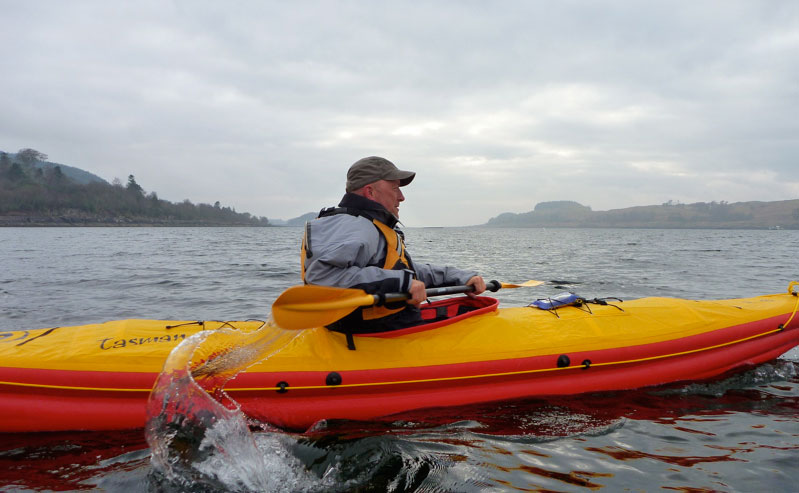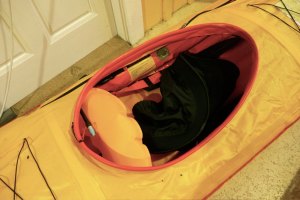The first stop of the day, for a snack and a bailing session … was on the beautiful little Isle Ristol, where the curve of a petite beach reached out to embrace the approaching kayak in a shingly grin. Here were the rudiments of rest and refreshment in a spirit of abundance without ceremony, from the free-spirited dreams to the always-islands which soften the horizon and bring comfort to the eye. It would have made a wonderful camp, but I had come only ten miles and was good for a few more yet, heading north, away from the sheltered jigsaw pattern of the Summer Isles.
‘Blazing Paddles’ (1988), Brian Wilson
Today was a bad day for sailing. But for everything else, including paddling, it was about as good as it gets up here. The skies were clear, the sea was still and the breeze barely rose above walking pace.
A day earlier I’d paddled off the beach 4km west over to Isle Ristol opposite Old Dornie anchorage. On that occasion, for the first time I actually sensed what must have been a helpful push from the outgoing 2-knot tide which was at its height at the time. Once at the island a lull presaged a change of wind direction and a light headwind rose up. So I popped into a small fissure for a look then sailed slowly back. With no rhythmic splish-spolsh, splish-spolsh, I realised how pleasant it was to be free of paddle noise and amused myself by shooting underwater vid with the rediscovered Go Pro. This ‘hands-free’ PA sail is still a novelty!
Today was going to require lots of splish and spolsh, but the tranquil conditions encouraged me to try something a little more daring: around Isle Ristol – all 4 or 5kms of it. It may not be Iceland or Tierra del Fuego, but there’s still a sense of accomplishment paddling out to- or right round an island.
And it’s always fun to paddle out of Old Dornie (left, and bottom of page) as by Scottish standards it’s quite picturesque. A few fishing and rec boats bob around and on a very low tide you can just about wade over to Ristol through the kelp.
I set off at midday; an hour of so before low tide which (by pure coincidence) should have meant negligible currents swirling around between the isles. As it was a warm day and the K40 had been strapped on the car since yesterday, I took the trouble to re-temper the air pressure once on the cool water. The firm kayak responded by gliding swiftly away from the jetty and when I just paddled normally, I was doing just over 4mph.
Low tide also meant more land to paddle around and I was forced out around the spur off the north of Ristol by the beach, and out into the unknown. Over the horizon a band of pink clouds lay over the Outer Hebrides as I passed a lone gull (all white seabirds are ‘gulls’ to me) perched on a rock, guarding the way to the open sea. I had a print-out of Ristol on my lap to read each passing inlet if, for some reason I lost my nerve. But beyond the sentinel gull, conditions remained tame.
Encouraged, I headed in towards a tumbled cliff and the dark cleft of a sea cave, as wide as my boat is long. New to such probing and aware of the risks, last week while exploring the cliffs along the east side of Achnahaird Bay, I’d dared myself to paddle into a similar cave, catious but intrigued. As here, the over-amplified swell spooked me as it reverberated out from the dank base of the cave, and I was pleased to get out of there quick before some rogue wave came in and pinned me against the ceiling. It didn’t happen so, as with this whole game, you do something scary once and survive unscathed, you get used to it.
Back in the open and heading further out, I watched for the intimidating swells which never normally reach the lee of the Summer Isles where I usually paddle, but none came. Could it be so easy? I entered the 500-metre passage separating the back of Ristol with Eilean Mullagrach and decided the probability of making it across to that outer isle and back without ending up on the wrong end of an RNLI press release was really quite high. A few weeks ago we’d met some campervaners on Ben Mor Coigach mountain (above left), a great ridge walk that looks down on Loch Broom, Coigach and over to the Assynt. They were also packboaters and mentioned paddling their Advanced Elements double out to Eilean Mullagrach. Crikey, they’re braver than us I thought, as the weather was not so stable back then, but they explained they had a full complement of VHF, flares and all the rest. They’d mentioned an arch and a stack on Eilean Mullagrach which had intrigued me.
I aimed across the passage towards a likely looking inlet of fallen rock, but as I neared it I pulled up, listening and watching the seabirds bobbing about like me, or taking a running paddle back into the air. It was nice to just kick back and relax at will instead of endlessly going somewhere before something bad happens; a common reaction to perceived exposure and anxiety, and not just when a mile offshore!
Fact is I’m morbidly fascinated and scared by the sea, which is partly why I was drawn to those two trans-Atlantic books. I’ve been reading a lot of other sea kayaking literature lately; back issues of OP magazine recounting unprecedented white-knuckle circumnavigations at record-breaking speeds, and just finished, Brian Wilson’s Blazing Paddles (quoted above). These yarns often sound like war memoirs; compelling and character-building experiences for sure, but not something I aspire to. Viewed from the outside, the UK scene seems to be one of testing yourself. Perhaps the prevalent conditions up here on the northwest coast demand it, because if you can handle it the reward is access to what must be one of the best sea kayaking locales in the world. But though I’m motivated by my own mini-challenges, such as reaching an island you could almost swim to, I’ve had my white-knuckle epics over the years doing other stuff.
At my age the appeal of sea kayaking is sedate touring which is what made Shark Bay such a memorable trip. Coast-hopping on calm, sunny days in warm water; what I’d class as ‘Mediterranean’ rather than Hebridean paddling. Like all the other means of transport I’ve used for more adventurous travels, a kayak is just the latest way of reaching and exploring wild places, rather than pitting myself against wild seas. Today, the edge of the Minch was more Aegean than Atlantic, and the calm conditions encouraged me to slow down and smell the sea breeze, nose around aimlessly or even just drift. For once no pressure to keep alert and moving in case an ill wind or foul tide called for the usual over-reaction.
As I turned into the inlet on Eilean Mullagrach, I saw the arch the campers had mentioned unfold before me (left), spanning 40 feet above the shore. At the top of the tide with the sea level 4 metres higher, it would be easy and fun to paddle under it in a low swell.
Pleased with my discovery I decided, heck let’s go crazy and carry on around Mullagrach too – or at least push out as far as I dare. I had no map for this island but knew it was about a quarter of the size of Big Ristol – 2 or 3 kms round – a lot less than an hour’s paddling, surely. As I rounded the southeast corner, there too was the stack I’d been told of, with the very same guardian gull on top, watching me like a beaky coastguard.
Again, at high water you could probably pass behind this stack; something to try for next time. I moved out west, into the dreaded Minch. With all land behind me, the light was suddenly much brighter, the pale blue sea stretching out to infinity. A light swell was breaking over some flooded skerries where a couple of cormorants looked out to the west as if waiting for something. Small jellyfish drifted past and I remebered how amazed I’d been to first encounter these exotic, dinner-plate sized blobs camping on the beaches of Arran in the mid-70s. Jellyfish? In Scotland? Whatever next – dolphins, harbour porpoises? We saw a pod playing out in the Bay one evening last week. Nice though it was to commune with nature, I was actually rather conscious of my exposure here and so paddled along briskly, keen to catch sight Reiff hamlet at the end of the Coigach peninsula, and the back of Isle Ristol soon after. At one point the swell got a little alarming and the boat squirrelled about, but I steadied my nerves – just keep paddling forward while avoiding the surf and rocks.
Coming round the north spur of Mullagrach where the low tide had annoyingly prolonged my excursion around another spur, what looked like a navy patrol boat came down from the north. What were they doing up here I wondered, and why were there people dressed as civilians on board? Perhaps it was something to do with the tall ships due into Loch Broom on the weekend, although the probable answer is right here.
By some geo-tectonic miracle, Isle Ristol turned up just where I’d left it less than an hour ago; with some relief my paddle past the edge of my known world was over. All that remained now was to dawdle back to Old Dornie, dipping in at an inlet or two along the way to see what I could find. At the back of one narrow chasm (left) among all the usual plastic detritus I picked out an odd buoy that looked like it was made of pewter (above left). Most probably it wasn’t a relic from the Mary Rose but merely corroded aluminium, but it struck me looking at it later it could be a circus bomb with a dangling fuse.
With it all at my doorstep and work that can wait, I’ve done some great paddling around the Coigach these past few months, but just as the weather’s settling it’s time to head back south. So, rounding the Isle I decided to head string things out and across to the ‘Wasp Factory’ bay where I’d had a memorable evening paddle when we first got here back in May. Today’s figure-of-eight tour of the Ristols had been a perfect climax to a short summer’s paddling in the Summer Isles. If you wait long enough, these days will come, even in northwest Scotland.


































